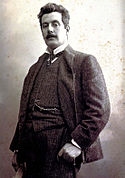Madame Butterfly - 'The End', by Byam Shaw
Identifier: favouriteoperasf00hadd (find matches)
Title: Favourite operas from Mozart to Mascagni : their plots, history and music
Year: 1910 (1910s)
Authors: Hadden, J. Cuthbert (James Cuthbert), 1861-1914
Subjects: Operas
Publisher: New York : Thomas Nelson
Contributing Library: Harold B. Lee Library
Digitizing Sponsor: Brigham Young University
View Book Page: Book Viewer
About This Book: Catalog Entry
View All Images: All Images From Book
Click here to view book online to see this illustration in context in a browseable online version of this book.
Text Appearing Before Image:
associated with her husbands return andalso later on with the child, the faithful Butterfly-recalls his promise to come back to her when therobins are nesting, the chirping of the birds beingindicated in the accompaniment; and she displaysher trust in his fidelity by describing their happyreunion in a charming song. The introduction here & (Return). S3 ¥-^- ^^trn^n^m etc of the death motive in unison appears to presagethat she will not survive the meeting. When theconcluding symphony dies away, the Consuls motive,and the marriage theme with its attendant strains,announce the arrival of Sharpless in the companyof Goro. During the scene between the Consul andButterfly, the warning phrase (26) is repeated fre-quently, pointing to the fulfilment of Sharplessprophecy in the first Act. Here also a theme 9. (Yamadori). P i t=pi etc. representing Yamadori is heard for the first time. Its occurrence at this stage seems to hint that Sharpless is going to favour the suit of this wealthy 224
Text Appearing After Image:
The end THE MUSIC lover. When Butterfly inquires of the Consulconcerning the nesting-time of the robins in America,the twittering of the birds is again suggested in theorchestra. As the Prince enters, his melody is pro-claimed fortissimo, the basses in unison accompaniedby the full orchestra. This melody, and the musicof this scene generally, have a specially Japanesecharacter. During the interview Butterfly lets themall understand that she still considers herself marriedto Pinkerton, and therefore, however poor she maybe, she cannot accept Yamadori. At this point thereis given out in the orchestra the theme alreadyreferred to, first sung by Butterfly to the words—** But the strongest oak must fall, when the storm-wind wrecks the forest. Presently the poor girl grows excited, and themusic reflects the state of her mind, as she expoundsher idea of the American law of divorce. Tea ishanded round to a phrase in dainty slow waltz rhythm,then Yamadoris theme accompanies his departure,aft
Note About Images
Relevante Bilder
Relevante Artikel
Madama ButterflyMadama Butterfly ist eine Oper von Giacomo Puccini. Das Libretto stammt von Giuseppe Giacosa und Luigi Illica. Es basiert auf der Erzählung Madame Butterfly (1898) von John Luther Long und der Tragödie Madame Butterfly. A Tragedy of Japan (1900) von David Belasco. Die Oper wurde in ihrer ursprünglichen Fassung als Zweiakter am 17. Februar 1904 im Teatro alla Scala in Mailand uraufgeführt. Die erste Sängerin der Titelpartie war die von Puccini verehrte Sopranistin Rosina Storchio. Die Uraufführung der dreiaktigen Neufassung fand am 28. Mai 1904 in Brescia statt. .. weiterlesen








